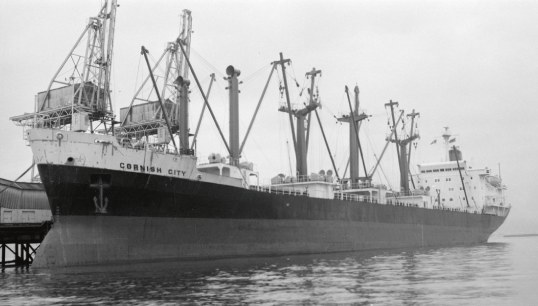Cornish City

Reardon Smith
The Cardiff-based firm was established in 1905 by a former seafarer, William (later to be Sir William) Reardon Smith, who had first gone to sea as a 12-year-old boy and rose through the ranks to become a master mariner.
The company's ships were originally used for the export of coal from South Wales, but after the First World War the fleet increasingly operated on a worldwide basis, including a regular service from the UK to the west coast of the US and Canada.
After losing 20 ships during the Second World War, the Reardon Smith fleet began to expand again during the 1950s, and in the early 1960s the company started to make the strategic move from general cargoships to bulk carriers.
The build
Built at the Upper Clyde Shipbuilders' Govan Fairfield yard, Cornish City was of 16,233dwt and 476ft 6ins (145.24m) loa, and was strengthened for the carriage of heavy cargoes such as iron ore. The vessel was originally powered by two in-line nine-cylinder two-stroke medium speed Ruston & Hornsby engines geared to a single screw, developing 9,000bhp and a service speed of 16 knots.
The design of Cornish City and sistership Welsh City reflected the company's belief that there would still be a demand for smaller ships that could run in and out of relatively minor ports, with the ability to load and unload their own cargoes. Both vessels were described as hard-working happy ships, with good accommodation.
However, they were less popular among engineers, as their original Ruston AO engines were prone to problems, getting through excessive amounts of lubricating oil and requiring frequent repair.
In 1973, both vessels were re-fitted with new V16 Pielstick engines in Aioi, Japan. One of the old engines from Welsh City was shipped back to South Wales and installed at the Llandaff College of Technology to be used for cadet training.
Deployments
Cornish City and sistership Welsh City entered service five years after the company entered the bulk trades. Frequently running between the US and Japan in their early years, both vessels carried a wide variety of cargoes, including grain, steel, and phosphate rock.
On its maiden voyage, a salvage tug had to be sent out to the North Pacific with spares following the failure of metalastic flexible couplings between the engine and gearbox.
Ownership
In 1977, with new tonnage – and some larger vessels – joining the fleet, Reardon Smith sold the two sisterships. Welsh City was switched to the Panama flag and re-named Jade Star before demolition in Alang in 1992.
Cornish City remained in service for a few more years, operating under the Panama flag as Neptune Star until 1992 and as Long Khanh, under the Vietnam flag, until scrapping in Alang in November 1997.
By that time, Reardon Smith was no more – with the company going into liquidation in 1985 in the face of poor freight rates, falling vessel values and the collapse of Celtic Bulk Carriers, a chartering joint venture it had formed with Irish Shipping in the early 1970s.
Cornish City fact file
When was Cornish City launched?
Cornish city was launched in 1969
What speed could Cornish City reach?
Cornish City had a service speed of 16 knots
When was Cornish City scrapped?
Cornish City was scrapped in 1997
Contribute
Are you knowledgeable about this vessel?
Submit your contribution to this article to our editorial team.
Write to usView more ships of the past
HMS Beagle
Launched 200 years ago, HMS Beagle has been described as one of the most important ships in history – thanks to the observations on evolution and natural selection that its famous passenger Charles Darwin made during a five-year voyage around the world between 1831 and 1836.
Common.ReadMoreHMS Beagle
Oxfordshire
The Oxfordshire had a 34-year long career as an emigrant ship, passenger liner and cruiseship.
Common.ReadMoreOxfordshire
Ruahine
Entering into service just over 70 years ago, the Ruahine was the last passenger-carrying ship built for the New Zealand Shipping Company (NZSC), and the third to bear the name – which means 'wise woman' in Māori.
Common.ReadMore